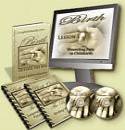Relaxation Techniques for Women Giving Birth Naturally
For women giving birth naturally, the most critical skill to master is relaxation. It may seem odd to consider relaxation a skill, but indeed it is.
Maintaining relaxation in the face of the unknown, in the midst of the
emotional journey into motherhood, can be a daunting task. If negative thoughts or self-doubt
creep into your mind, they can undermine your ability to turn your body over to birthing and
ultimately make your birthing a painful experience.
To illustrate the skill of maintaining relaxation amidst distraction, Pam England, in her
book Birthing from Within, suggests taking the "ice cube" test: holding an ice cube in your
hand when you think you're completely relaxed. After a few minutes, you will most likely find that
your "relaxation" has vanished.
Relaxation techniques can be applied to every aspect of
your life. The benefits of relaxation for
improving people's physical and mental health have been well documented.
Barriers to Relaxation
To birth your baby, your body must open. Tense, tight muscles impede that opening. If you condition your body now to stay relaxed in the face of distraction, you will be better equipped to slip into deep relaxation during labor and birth.
Different factors may impede women giving birth naturally from fully relaxing, including
their perceptions of childbirth. If a woman
harbors negative connotations or phobias about childbirth, these feelings can interfere with her
ability to trust her body and truly relax. Any of the following techniques may be employed to
learn relaxation for childbirth. Before starting them, read the guidelines for
implementing relaxation techniques for
childbirth.
Relaxation Techniques
There are many
avenues available to learn relaxation. The key is finding what works for you. Some of the most
commonly used methods include:
Relaxation Scripts
A relaxation script is a critical birthing preparation tool. These scripts can be read by a partner or alternately, you can choose a relaxation audio cd instead. Through daily practice, you will condition your body to immediately relax under any circumstances. Daily relaxation practice is the key to pain-free births.
Progressive Muscle Relaxation
Progress muscle relaxation techniques can be particularly effective for women giving birth naturally. With this technique, you learn to actively tense and then release individual muscles or muscle groups. By doing so, you learn to discriminate tense vs. relaxed muscles and ultimately maintain a relaxed state at will.
Visualization
Visualization can be a powerful tool for women giving birth. This is a technique commonly used by athletes. You learn to visualize the whole experience of birth-from early labor to delivery. In your mind, you picture all aspects of your birthing - from the smells around you to the background noises and even the lighting - and how you will react to each new development. When we see ourselves successfully giving birth naturally, we are better able to trust our bodies when actual labor begins. A guided imagery exercise in which visual imagery represents the birth process, such as picturing your body opening like the petals of a flower, can also be effective. Hypnobirthing: The Mongan Method contains several quality imagery scripts.
Music
Music speaks to people in many ways. It has such a varied impact upon people. Music can be used as a tool to evoke emotions across the spectrum-from energizing and invigorating to soothing you to sleep.
Women giving birth naturally benefit by using relaxation music as part of their relaxation routine to instill relaxation at the first strains of that familiar melody.
Whatever method or methods you choose, they will be most effective with consistent practice. So the next time you sit back and put your feet up, remember you're hard at work preparing for your birthing!
References
Smith CA, Collins CT, Cyna AM, Crowther CA. Complementary and alternative therapies for pain management in labour. Cochrane Database of Systematic Reviews 2006, Issue 4. Art. No.: CD003521. DOI: 10.1002/14651858.CD003521.pub2.
Anim-Somuah M, Smyth R, Howell C. Epidural versus non-epidural or no analgesia in labour. Cochrane Database of Systematic Reviews 2005, Issue 4. Art. No.: CD000331. DOI: 10.1002/14651858.CD000331.pub2.
Hodnett ED. Continuity of caregivers for care during pregnancy and childbirth. Cochrane Database of Systematic Reviews 2000, Issue 1. Art. No.: CD000062. DOI: 10.1002/14651858.CD000062.
Cluett E R, Nikodem VC, McCandlish RE, Burns EE. Immersion in water in pregnancy, labour and birth. Cochrane Database of Systematic Reviews 2002, Issue 2. Art. No.: CD000111. DOI: 10.1002/14651858.CD000111.pub2.
Return from Relaxation Techniques for Women Giving Birth to Giving Birth Naturally Home
Page Last Modified by Catherine Beier, MS, CBE
Most Popular
How to Use Acupressure to Induce Labor
Childbirth Relaxation Script MP3s
Nutrition During Pregnancy - Nix the Notion of Eating for Two
Looking for a Birth Professional? Search our Provider Directory
Online Childbirth Classes
Choose 7 week, 12 week, or Self- Paced online childbirth classes available wherever and whenever you need them.
Featured Birth Story
Vanessa's natural birth story shows that when birth is left alone to proceed as it should, it waits for no one - not even doctors or midwives.
Free Pregnancy Tickers
Create a free pregnancy ticker to post on your blog, website, Facebook profile or favorite social media...




